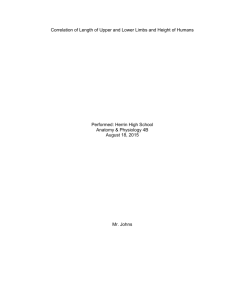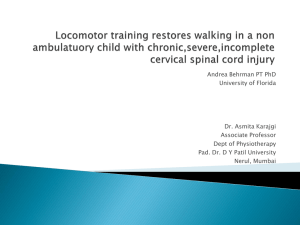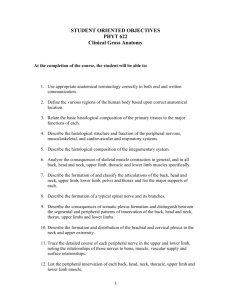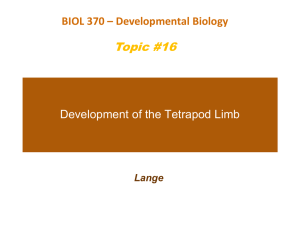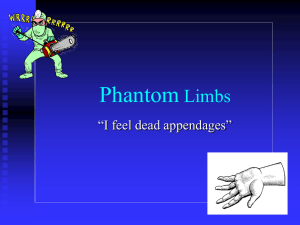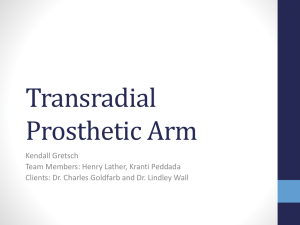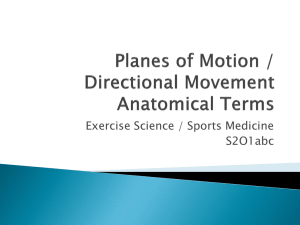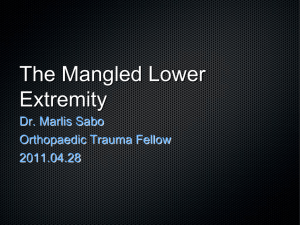- eResearch - Queen Margaret University
advertisement
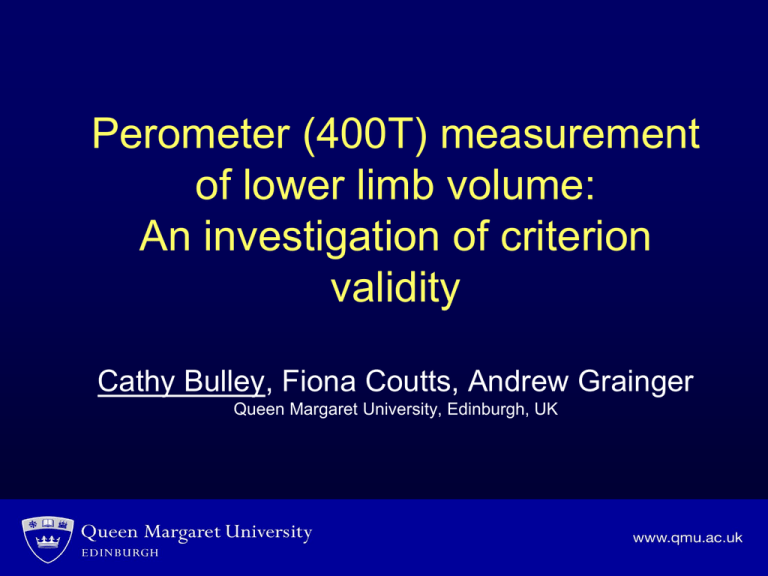
Perometer (400T) measurement of lower limb volume: An investigation of criterion validity Cathy Bulley, Fiona Coutts, Andrew Grainger Queen Margaret University, Edinburgh, UK Background • Various musculoskeletal conditions limb volume • Limb volume – outcome measures Fluid displacement Geometric calculations from limb circumferences using tape measure Perometer – optoelectronic imaging device; limb shape and volume (Pero-System GmbH) Current Methods • Fluid displacement: limb submerged in water, measurement of fluid displaced inconvenient unhygienic poor reliability no information on shape • Geometric calculations from limb circumferences using tape measure frequently used clinically non-standard protocols reliability issues Circumferential Measurement • Limb circumference at specified points on limb – quick, simple • Lack of agreement on measurement points – specific anatomical landmarks or regular intervals e.g. 3 or 4 cm (Karges et al, 2003) • Geometric formulae to estimate volume of different segments summed • Different formulae used (e.g. disc model, truncated cone model) • Reliability issues: e.g. tape measure tension (Brorson, 2000) Perometer (Pero-System GmbH) optoelectronic imaging device Track limb shape and volume quick, easy Frame Base plate Perometer estimation of limb volume Positioned every 2.54 mm Diameter measurements every 4.7 mm Positioned every 1.27 mm Summed volume of elliptical discs Purpose • Perometer – gold standard? • Face validity • Lack of standardised protocol and research • Criterion Validity: This study compared lower limb volume measured using : Geometric calculation from limb circumferences (Tape measure Disc model method, Man et al, 2004) Perometer (400T: upright model) Standardised Protocol • Development of a standardised protocol Limb position on the base plate, and degree of rotation Lower limb landmarks – standardised proportion of the limb for volume measurement Greater trochanter 65% Femur Lateral epicondyle Lateral Malleolus Validity Study • Ethical approval: Physiotherapy Ethics SubCommittee, QMU. • 30 healthy volunteers: 22 F, 8M mean age: 26 mean height: 67.2 cm mean weight 171.0 kg. Exclusion criteria: relevant past medical history Protocol 1 • Participants requested to avoid vigorous exercise / alcohol consumption 24 hr before testing and avoid food / drink intake 1 hr before testing • 15 minute rest period with limb elevated to 90° • Standardised limb reference marks Protocol 2 • Standardised limb reference marks • Standardised positioning of limb in Perometer frame – use of spirit level • Three Perometer measurements • Tape measurements at 3 cm intervals • Assessor blinded to limb volume Limb volume estimation • Perometer: Volumes in ml calculated between two reference marks in perometer computer software • Tape measurements: Disc model method (Man et al, 2004) in ml (1ml = 1 cm3) Σ (C²/4π) x h C = circumference of disc h = height of disc Statistical Analysis • Shapiro-Wilk: Normality of distribution • Parametric inferential statistics: ICC (3,1) Limits of agreement (Bland & Altman, 1986) between two limb volume estimates Results • Perometer limb volume (x of 3) = 8560 ml • Normal distribution p=0.268 • Circumferential limb volume Difference = 8717 ml 157 ml • Normal distribution p=0.602 • ICC (3,1): good association (0.952, p<0.001) • Poor agreement 15.67% variation between estimates: 95% of Perometer estimates will be: between 519 ml (6.01%) more and 834 ml (-9.66%) less than circumferential estimates Bland-Altman LOA for Perometer and Cicumferential Measure 760 Differences in mean volumes of Perometer and Circumferential Measure (ml) 660 560 Mean + 2 S.D. 519.19 mls 460 360 260 160 60 -40 6000 7000 8000 9000 10000 11000 -140 12000 Mean -157.48 mls -240 -340 -440 -540 -640 -740 Mean - 2 S.D. -834.25 mls -840 Average limb volumes by Perometer and Circumferential Measure (ml) Conclusions • Poor agreement – measurement methods are not interchangeable Perometer – greater face validity Circumferential – more clinically feasible • Results do not indicate accuracy of either method • 21 / 30 data sets – overestimation by circumferential method • More work is needed to determine accuracy Acknowledgements MSc pre registration Physiotherapy students: • Nicola Dinsmore • Georgina Enderson • MaryAnne Geraghty THANK YOU Sponsors: School of Health Sciences, Queen Margaret University, Edinburgh Centre for Integrated Healthcare Research, Edinburgh References • Bland J, Altman D (1986) Statistical methods for assessing agreement between two methods of clinical measurement. The Lancet 8: 307-310 • Brorson H (2000) Liposuction gives complete reduction of chronic large arm lymphoedema after breast cancer. Acta Oncologica 39: 407-420 • Karges J, Mark B, Stikeleather S et al (2003) Concurrent validity of upper-extremity volume estimates. Physical Therapy 83: 134-145 • Man I, Markland K, Morrissey M (2004) The validity and reliability of the Perometer in evaluating human knee volume. Clinical Physiology and Functional Imaging 24: 352-358
